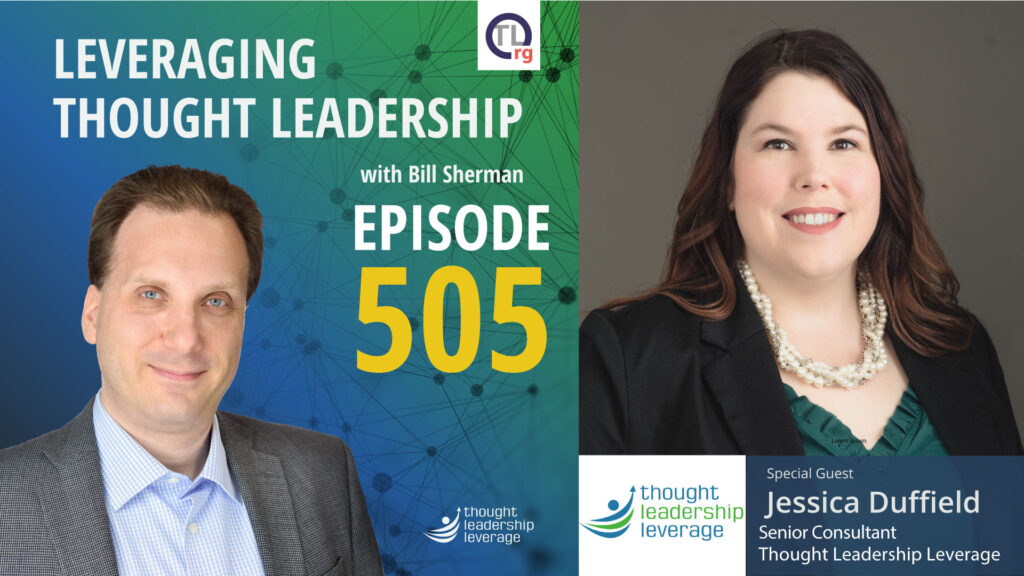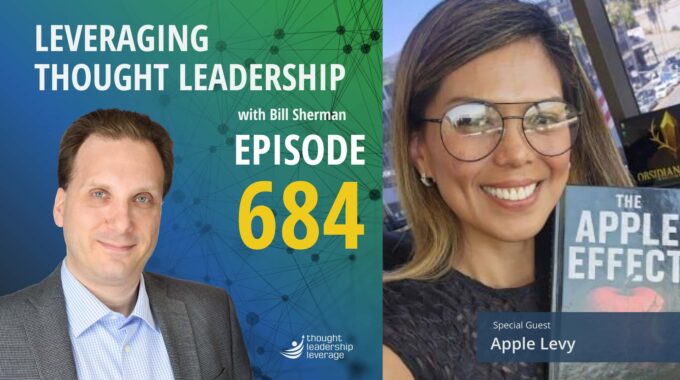A field-tested framework for leaders who want better margins, cleaner operations, and a stronger culture…
Why Good Ideas Alone Are Not Enough | Jessica Duffield

Making your ideas discoverable, digestible, and desirable.
An Interview with Jessica Duffield about working with thought leadership clients to create content that resonates and building client avatars.
Thought Leadership can be very complicated, with nuanced ideas and industry jargon.
Unfortunately, complex language and niche ideas won’t catch your audience’s attention!
To explore how to take big thought leadership ideas to market, I’ve invited Jessica Duffield to join me. Jessica is a Senior Consultant at Thought Leadership Leverage. She’s worked with clients for nearly 10 years, helping them create content, find their best audience, and go to scale with unique ideas.
We discuss the most effective ways to take big ideas and turn them into bit-sized content, ensuring your audience will notice them – and easily remember the content. Jessica walks us through the process of finding the strongest core ideas of your thought leadership and focusing on those, creating a simplified vision of your content that can be easily grasped.
In addition to breaking your content down, you need to know your audience – who do you want to work with and for? Jessica gives valuable advice not only for finding your audience, but understanding their needs, worries, and where they are within their organizations.
Additionally, we discuss the need for a hook that will grab your audience quickly. Jessica shares how and why sharing your story authenticity can be the “hook” you need to get your audience to stop scrolling and want more.
Three Key Takeaways:
- You often only get a few seconds to grab your audience’s attention. And if you can’t evoke interest and curiosity in your idea in that time, you’ve failed.
- When creating content, sometimes you’ll have to “Kill Your Darlings” to maintain focus on the most important facets of your thought leadership and your audience.
- Big ideas don’t have to be complicated. In fact, making your ideas easy to understand means a larger audience will be able to consume your content and follow you to the next level.
If you need a strategy to bring your thought leadership to market, Thought Leadership Leverage can assist you! Contact us for more information. In addition, we can help you implement marketing, research, and sales. Let us help you so you can devote yourself to what you do best.

Transcript
Bill Sherman Over my career, I’ve seen too many good insights get stuck and forgotten. Thought leadership practitioners need to be scrappy because there never seems to be enough time, resources or budget to reach the people you need. So how do you make the most of constraints through thought leadership? Today, I speak with our own Jessica Duffield. She’s a senior consultant here at Thought Leadership Leverage. And Jessica and I have worked together on many projects over the past nine years. Jessica has helped people sharpen their ideas, focus their effort on audiences and create impact. It’s time for Sharp Talk about thought leadership.
Bill Sherman I’m Bill Sherman, and you’re listening to Leveraging Thought Leadership. Ready? Let’s begin. Welcome to the show, Jessica.
Jessica Duffield Happy to be here, Bill.
Bill Sherman So individuals and organizations have good ideas which are sort of the backbone of thought leadership. You need ideas. But I want to spend some time with you asking the question, why isn’t a good idea enough?
Jessica Duffield Well, there’s a lot of things at play, Bill, about a great idea or a good idea and what gives it legs. And while it is a little bit about the excitement that you might have with your idea, I think it’s also important to understand your audience and how you want to reach them. So often in my experience, we talk to clients about simplifying language and sometimes our own jargon. We get so wrapped up in it, repeating it to our clients all the time that sometimes the best details get lost because we’re speaking our language, they’re speaking theirs. So really distilling down your ideas to simple, plain language that anyone can understand quickly is important. And I think that we often, like I said, get caught up in our own minds and our own jargon. And sometimes that can get lost.
Bill Sherman So let me jump in here for a second. If I understand where you’re framing correctly, you’re saying human nature in some ways makes us want to make a smart idea sound complex, but really the challenge is making the smart idea simple.
Jessica Duffield Yes. Basically, bite size information. And the reason we say that and we recommend it is so you can build upon it. So maybe right now we want to talk about how a candy bar is made. Well, we’re not going to get into the complex machinery of how the caramel gets in the Caramilk bar. But we will talk about the simple, simple, basic things, like how the chocolate is made and how the caramel is cooled. And we’re not going to get into all the logistics in the beginning because we’re going to lose our audience. So. So makes sense.
Bill Sherman It does. It does. And I think, as you say, it’s human nature. We spend time thinking about a really good idea. We spend our time digging deeply into the nuance of it, and we want to share all the nuance and all the details that we find interesting. Meanwhile, everybody as a listener is going, we’re back on first base. What are you talking about.
Jessica Duffield And how is this relevant to me? And I think that’s something that everyone asks right when it goes over their head or they’re lost in the jargon. How does this connect with me? So it’s a little bit of both. I don’t want to say dumbing down the language because that’s not it. It’s just simple language and finding little intricate ways that you can connect with your audience and understand them just as much as you can share the message. So nothing’s lost in translation.
Bill Sherman Well, and I think from a social media perspective, we all are doing that. Is this relevant, right? We go through and scroll through our feed and we’ve gotten good at being able to look in a quarter second and go, Nope, not reading that. Moving on. And we’re always evaluating messages. Sometimes messages contain ideas, but we’re looking for is this personalized to me versus, well, spam or sponsored content, right? Yes.
Jessica Duffield Yeah.
Bill Sherman So how do you get it so that someone listens, that you catch their attention? Because it’s really hard.
Jessica Duffield It is really hard. And I think it really takes a bit of reflection of determining who you want your audience to be and getting a clear understanding of what they lean into long before you even create your message. Having an understanding of do they? Do they digest information on Instagram? Do they scroll LinkedIn all day? Where are they going to get the content that they’re looking for and where are they spending their time? And it takes just a few moments to sort of do a little bit of research to try to understand your audience. And then really, it’s about finding the modality that will reach them the easiest and the quickest, but also catch their attention and keep their attention.
Bill Sherman So if I’m Archimedes and have a great idea in the bathtub and I now understand how, you know, water gets displaced, jumping out of the bath and running through the streets shouting Eureka isn’t going to be an effective way to communicate that message, right?
Jessica Duffield Absolutely not.
Bill Sherman Yes, because nobody has the context. Nobody knows. And even though that’s a silly example, in some ways, it’s one that’s been passed through us anecdotally through history. But that’s a great example, I think, of the person with the brilliant insight, not shaping a message for an audience, right? Everyone in the town would be like, What the heck is this naked guy running through the streets shouting Eureka! For?
Jessica Duffield Absolutely.
Bill Sherman So targeting your audience, I think one of the things that comes to mind is letting go that not all ideas are for everyone. What do you think about that?
Jessica Duffield I think that as we create content, sometimes it’s important to, as my writer colleague would say, kill your darlings. And often we’re so wrapped up in our prime message or our prime content that it’s hard to let go of some of the details. And I think it’s important that maybe we keep everything compartmentalized to where we think it needs to go, but also at the same time accept that, like you said, something is sometimes some things aren’t for everyone. And it’s really about understanding where the square peg goes in the square hole and not trying to continuously put a square peg in a round hole.
Bill Sherman So give me a sense, an example, because I know you’ve worked with a number of folks who are on the ideas creation side. Right. You talk about that process of suitability and being willing to kill your darlings on that. And that’s more than just favorite turns of phrase. That’s something deeper. Let’s stick there for a moment. What does that look like, really? And how do you know when something is a darling versus. Yeah, that’s a gem that really helps your ideas shine.
Jessica Duffield And that’s a great question. And I think it’s been different for everyone that I’ve worked with. I find that and I said this to a client once and it really stuck with me and I still try to use it today when they’re first talking to me about their core IP. What makes their face laid out? What do they feel the most passionate words? Often it’s really easy to pick that up in those early conversations. And I always try to earmark some of those key things they’ve mentioned because really that’s where their content is going to root from, is that place of, you know, what puts a fire in their belly. What did they get up for in the morning? And when you start to hone in and figure out what that is, you can also see sort of all the extra pieces on the outside of it that really can fall away and let their core ideas shine.
Bill Sherman I think you touch on something that a lot of people don’t look for, but I think you and I have discovered is incredibly telling those nonverbals. You can see that core in the eyes and you can feel the energy when someone’s really, really talking about the message that they care about most deeply. Absolutely. So let’s talk about that process of letting go and knowing who your audience is. How do you do it? I mean, because it’s easy to say. My. My big ideas for everyone. Right. How do you do it?
Jessica Duffield I think there’s a few steps. You really need to know who you want to be working with. Who do you want to be selling to? You need to have an idea of who those people are. Maybe you spend a little bit of time on LinkedIn looking up those people, what their interests are, where they’re posting, where they’re commenting, and then it gives you an opportunity to see how these key ideas of yours might complement them. So it’s really just taking the time to really find understanding of your potential audience, but also not just trying to overwhelm them with your information, like drinking from a fire hose. You want to, like we said before, kill some of your darlings and take the things that you’re passionate about. Well, who’s talking about that on LinkedIn right now? Make a hashtag or two about what you love and what where you want to be in your key ideas. So who’s talking about that? How much traffic is that getting? Are you engaging with other people talking about that? I think just doing a little bit of that sort of grassroots research, as much as that’s what it is, I think it really gives you lots of information that helps just determine where you want to go, what you want to hold on to and what you want to let go of.
Bill Sherman Well, and you suggested something there of where is the conversation that I think sometimes gets lost both on the individual and the organizational level? Fault leadership isn’t a megaphone that you use just to shout at everyone your big idea. It’s a conversation. And if you’re not listening and responding, you’re really just adding to the noise. You’ve got to join the conversation.
Jessica Duffield That’s right. And I think there’s so many people built that are just I mean, let’s all be honest. We spend more time, I’ll say, lurking on our socials than we do interacting. But there’s a little bit of a proof in the pudding, so to speak, when I know I’ve been active deliberately for 30 days on LinkedIn, I’ve been commenting, I’ve been liking things, I’ve been asking questions. I see that come back tenfold to me by making new connections. People I may have never met before because they see me interacting with content they care about. So I think that’s important. And I think you’ve seen those same results yourself, you know, in how you manage your LinkedIn. And I think there’s something to be said about investing that time and authentic interest in other people and interacting with them. I think that’s, you know, one of the easiest ways to really find your place.
Bill Sherman Well, and dividing that into short form and long form. Right. So as an organization. You can put out the white paper. You can do the research study. But breaking that down into. Can you share your big idea, the same big idea that lives in the white paper. Can you share it on the cover of the White paper and have someone get it? Could you make that big idea into an infographic? And have people say, Hmm, I want to know more about that. Is that really true? How does that work? Right. If you can’t evoke interest in curiosity with your idea, you’ve failed and you may have just a quarter, second or a half second of someone scrolling through that feed lurking, like you said. That’s tough.
Jessica Duffield Yeah. Creating the hook is really where it’s at. And for years, well, we’ve been adding a hook on things we create in social media or at the beginning of a white paper so that we get, you know, people to read the other 13 pages of it. But I think that hook has to have some authentic components. It can’t come across as salesy. It can’t come across as fake or pushy. It has to catch your attention in a way that resonates with you in an authentic way. And I guess that is where you find out who really is leaning into your content and who isn’t. And that’s sort of a tool to vet the right people, right? It’s in a way of like, who’s going to lean into this? Well, if they leaned in and saw the front page of my white paper and they sent me a message because they want to know more. That’s my audience. They found me.
Bill Sherman It may be for some level, but they may not be buyers. Right? They may be end users. And that’s the distinction.
Bill Sherman If you’re enjoying this episode of leveraging thought leadership, please make sure to subscribe. If you’d like to help spread the word about our podcast, please leave a five-star review at ratethispodcast.com/ltl and share it with your friends. We’re available on Apple Podcasts and on all major listening apps as well as thought leadership leverage dot com forward slash podcasts.
Bill Sherman And I want to pause here because you’ve done creation of probably more thought leadership target avatars of who are we trying to reach than many if not most. Right. You’ve done that process of saying who are our primary audiences? What has that experience been like and what have you learned working with organizations and clients again and again? What makes a good avatar for thought leadership?
Jessica Duffield Oh, well, that’s a good question. And ironically, just a fun fact. I think it is around 450 buyer avatars in my tenure of nine and a half years.
Bill Sherman That’s what I was thinking. Yeah, So we’re talking that number.
Jessica Duffield Yeah. I think over the years, what’s really been interesting to me is that as clients talk to us about helping them create these lists for target avatars and then we go ahead and do the research, is that sometimes it is a struggle and I mean this in a good way for the client to see beyond their current reach. And that has been sort of I always find that is the rewarding challenge when engaging with clients to push them beyond what they’re comfortable with and what they know and think about how their content can serve outside of the lane that they’ve been serving. And really in most cases that is one of the reasons they come to us is so that we can help them see beyond where they’ve been selling in the market. So I think sometimes we like to challenge where their content has been. Sometimes we like to just turn it on its head and see how it works in a whole other market. But I think in doing that, many buyer avatars over again, like I said, the last nine and a half years, there are your standards that always seem to be recurring. You know, no matter what business you’re in, there’s always going to be, you know, a C-suite avatar out there that we’re trying to target. But what’s really interesting that I found, I would say in the last five years would be the I’ll call it the Fanatic avatar. It’s someone who has been following you on social media for the last three years. They’ve gone to your keynotes. Maybe they heard you speak at something, something else, and they were only in a mid-level position, but now they’re not. And now they want you. And this is becoming a recurring avatar more and more over the last five years is that someone they interacted with five years ago is now in a buyer’s position or a decision making position with budget. And they’re ready to talk. They’re ready to implement what you have with the rest of their company.
Bill Sherman Well, and that’s a fascinating thing, right? It talks to the long tail of thought leadership and why reaching smart audiences, even if. They’re a little bit junior is valuable because you wind up getting these longtime listener first time caller.
Jessica Duffield Yes.
Bill Sherman Opportunities where someone says, Hey, I’ve been following your stuff, I love it, and now I’ve got a problem with my team, my division, my organization, and your solution. And your organization, I know, thinks the way that we need. They’re not going to go and look to put this out to bid and to tender for a large audience. They’re going to come to you and say, How would you solve this for us? Right? And you’ve built loyalty even before they were ready to buy.
Jessica Duffield Yeah. And it’s becoming more and more visible in the work we do. And we see people who show up and who know other thought leaders we’ve worked with. They’re like, oh, yes, I worked with them five years ago and now I’m going to I’m going to leave a review on their book or I’m going to go out and talk about their book on LinkedIn for them. Like, all these connections happen and it’s really just about. I hear the Canadian in my about my apologies. No need. It’s really just about cultivating those relationships. And, you know, it only takes a little bit of work and very little touch to just stay stay in contact with someone you met five years ago that inspired you in some way.
Bill Sherman Well, and one of the things that I know and you know is when you start connecting within the world of thought leadership, both on the organizational side as well as the individual practitioner side, it’s a small world of those of us who are working and practicing thought leadership. It’s not like trying to know every sales person in North America. No, you can know who your colleagues are who are practicing thought leadership. You can learn from them. You can connect with them in many ways. So we’ve talked about avatars. I want to distill down on something in terms of getting the message simple. And we’re cycling back to this. Right. And the ability to explain what your idea is in 30 seconds or 60 seconds. Right. But you’ve had to do a lot of work with clients on that. And often that starts as a hard process. So let’s talk about that. How do you take a complex idea and set a hook and give an Aha. In 30 to 60 seconds?
Jessica Duffield So it’s interesting because oftentimes we would ask our clients to give us the elevator pitch, the jargon free elevator pitch. And sometimes we get that. Oftentimes we don’t we get a lot of jargon, language that creates complexity and doesn’t get the message across in 30 to 90 seconds. So really, in that exercise, we challenged them to really think more simply in how they would tell someone that maybe isn’t even in business with them what they do. And really it’s an activity of taking a few short paragraphs that would describe their thought leadership and trying to simplify it even further. And I think sometimes it’s easier for them to look at, okay, these are the 3 to 5 core concepts. Now I can go back and I can simplify that 30 to 90 second blurb when they can just hit those core pieces. But sometimes it’s so hard to see the forest for the trees.
Bill Sherman And you’re trying to set up so many ideas and nuances in there. You’re afraid of letting anything go. And really, that core messaging, you’ve got to pick one idea, maybe a couple supporting points and go with that. I used to say in some ways it’s being able to explain your big idea to someone in your family. But I have also played around with the language of can you explain it to a first grade classroom? Right. Can you explain it to first graders and their teacher? Now their teacher is going to have a different nuanced understanding, but they’re going to be an educated person, but they’re not going to be in your lane and in your world. And so with the ability to break things down and talk on multiple levels so that depending on your audience, they can key in on different things, that’s essentially.
Jessica Duffield Agreed, 100% agree.
Bill Sherman So you’ve said that you’ve been in this world of thought leadership for nine and a half years.
Jessica Duffield Yes.
Bill Sherman What advice would you give your younger self?
Jessica Duffield That’s a great question. And I think I would say to appreciate the opportunities of getting to get a masterclass in so many wonderful topics. I did not appreciate that ten years ago the way I do now. And I can look at my bookcase and think of all these amazing people I’ve had. The opportunity to work with and really only now appreciate the early days and how much I learned so quickly. But also, you know, building relationships with people that I’m still, you know, continuing them today. So the advice I might give younger me would be, hang tight, it’s going to be a wild ride and you’re going to meet some amazing people and take none of it for granted.
Bill Sherman Fantastic. Thank you very much for joining us today, Jessica.
Jessica Duffield Thanks for having me.
Bill Sherman If you’re interested in organizational thought leadership, then I invite you to subscribe to the OrgTL newsletter. Each month we talk about the people who create, curate and deploy thought leadership on behalf of their organizations. Go to the website. OrgTL.com and choose ‘join our newsletter.’ I’ll leave a link to the website as well as my LinkedIn profile in the show notes. Thanks for listening and I look forward to hearing what you thought of the show.





